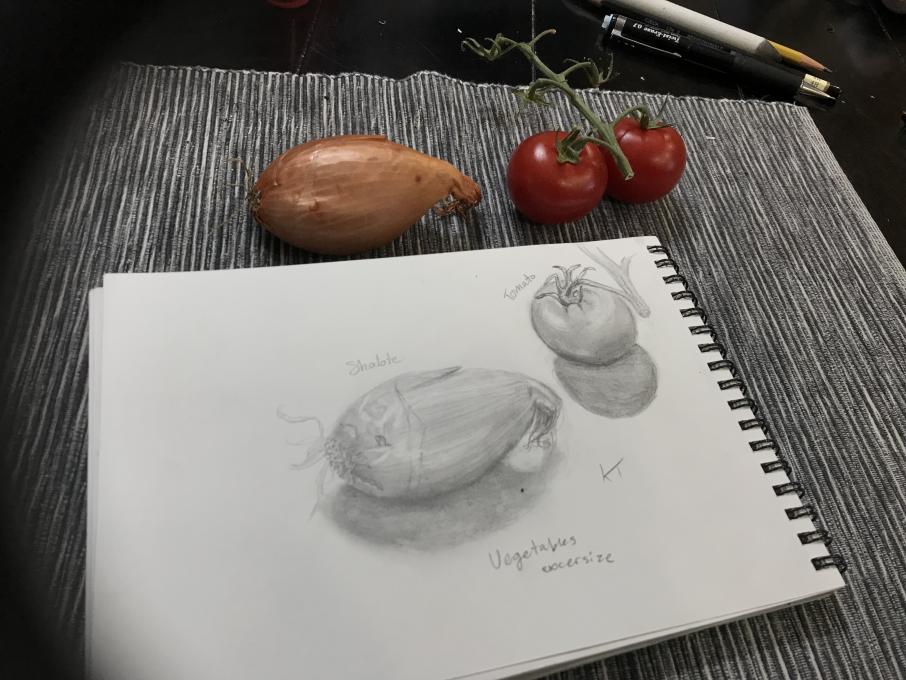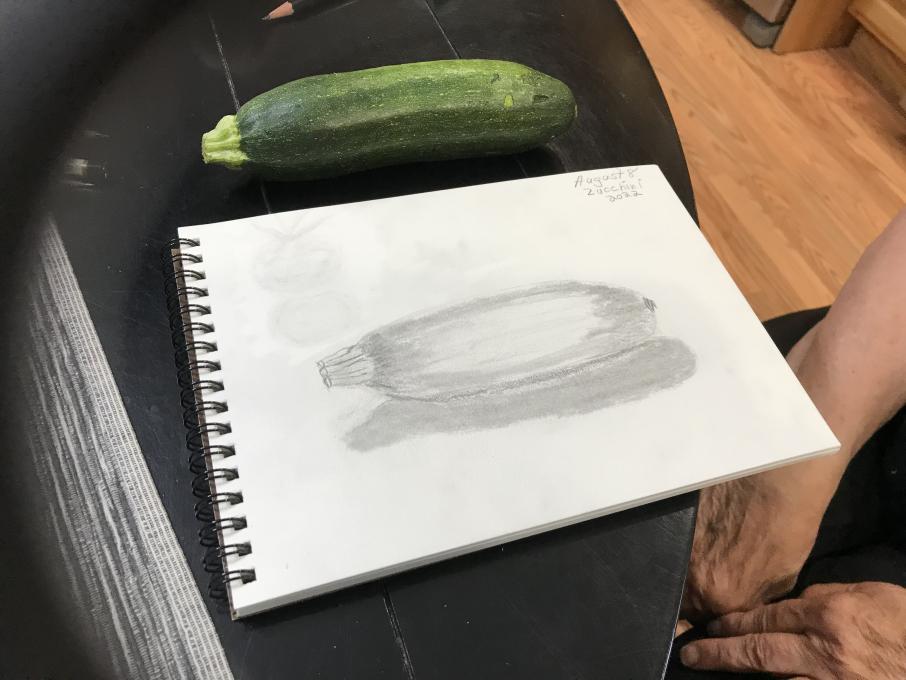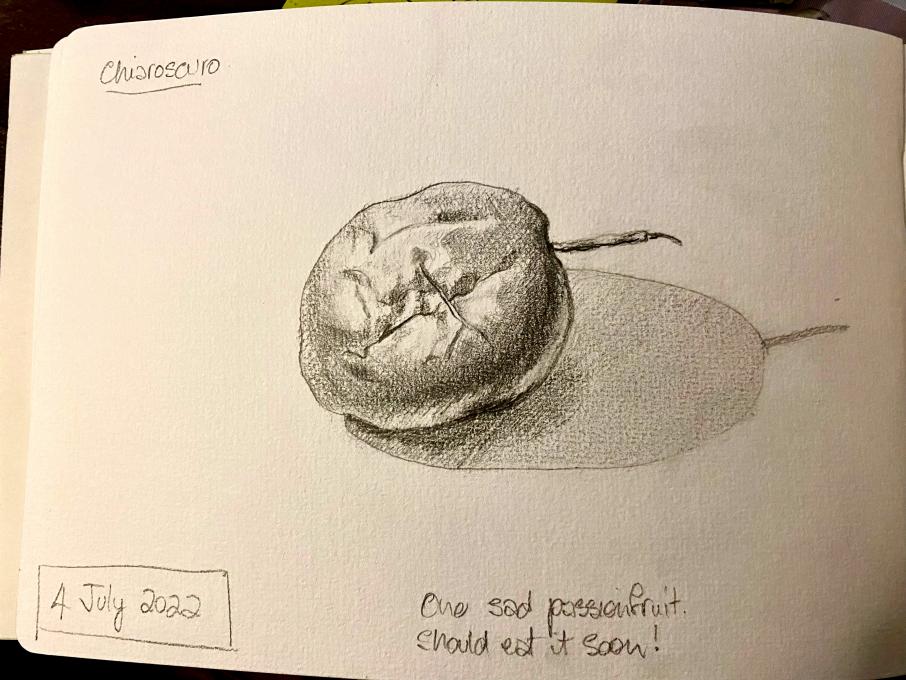The Cornell Lab Bird Academy › Discussion Groups › Nature Journaling and Field Sketching › Illustrating the 3D World
-
Learning about chiaroscuro helped me place the light and dark areas on my paper more precisely, but I definitely need more practice.
-
 Was fun looking for the various parts of the chiaroscuro. I was curious that my mango had another band of shadow below the reflected light - I think it might have been reflected off the darkest cast shadow? I was glad for the freedom to experiment with the different types of marks - sometimes the hatching was enough, but I found myself cross-hatching and scribbling too. I appreciate others' comments on the difficulty of finding the chiaroscuro in a highly textured object!
Was fun looking for the various parts of the chiaroscuro. I was curious that my mango had another band of shadow below the reflected light - I think it might have been reflected off the darkest cast shadow? I was glad for the freedom to experiment with the different types of marks - sometimes the hatching was enough, but I found myself cross-hatching and scribbling too. I appreciate others' comments on the difficulty of finding the chiaroscuro in a highly textured object! -
 I did not care for my former attempts at creating three d. I am blaming it on the 10.5 inches of snow. I went to the Audubon center that is near and sketched the bear. Hope this is better.
I did not care for my former attempts at creating three d. I am blaming it on the 10.5 inches of snow. I went to the Audubon center that is near and sketched the bear. Hope this is better. -

-
 I remember this being hard in my high school art classes, and it certainly hasn't gotten any easier. I feel like it got a little easier with each attempt, although I certainly have a long way to go! I also want to work on my light, sketchy marks -- my tendency is to go too heavy and dark right away.
I remember this being hard in my high school art classes, and it certainly hasn't gotten any easier. I feel like it got a little easier with each attempt, although I certainly have a long way to go! I also want to work on my light, sketchy marks -- my tendency is to go too heavy and dark right away. -

-

-
I like the looseness of this rendering. It makes me want to give scribbling another look!
-
-
 Very fun...but not very realistic...not a chicken! it is an onion!! ha...I loved learning about Chiaroscuro. I love that kind of information because it helps me to better understand what I'm seeing.
Very fun...but not very realistic...not a chicken! it is an onion!! ha...I loved learning about Chiaroscuro. I love that kind of information because it helps me to better understand what I'm seeing. -
 For me this is a whole new way of looking at things. I can see how the different shading and blending techniques really make a difference in your drawings. Lighting makes a difference too. Today was very cloudy and the lights in my office were casting weird shadows which made it difficult for me to see some of the highlights and shadows.
For me this is a whole new way of looking at things. I can see how the different shading and blending techniques really make a difference in your drawings. Lighting makes a difference too. Today was very cloudy and the lights in my office were casting weird shadows which made it difficult for me to see some of the highlights and shadows.
-
I like being able to use different shading techniques, and especially the blending which is new to me. Thank you. I found that some objects are easier to shade/shadow than others. For example, a lightly tanned potato was difficult because the smooth skin mostly looked the same from any angle. The image inserted below shows what I selected as a difficult object--for a beginner--to draw, namely a piece of firewood (which I had sawn and chopped for our wood stove!) I would appreciate a critique, please. When all the colors are similar shades of brown and gray, how do we differentiate? Suggestion: Could Liz or a colleague present a demonstration video on how to shade complex objects, such as a log?In other words, could the class have an additional video that applies our basic skills in shading the ball, chiaroscuro, to show how to tackle a more difficult object, please?

-
Very good question! I've often wondered how to differentiate between shadow and color in a black and white drawing -- hope someone has an answer. Your log is beautifully rendered, and I think you could have gone even darker in some sections.
-
-
these are garlic and tomato, I wish they'd look more 3d. Need more practise I guess!

-
I can see the changes in light on objects a lot more now. My eye searches for the different shades in the shadow too. I am drawing objects to compare shading so yes drawing a lot more than I ever have before and enjoying learning about light reflection. I have never studied that before now.
-
I guess rome wasn't built in a day. They are very rough but I did learn alot in this exercise. It's fun to look at the variations in light and shadow. I'm not a very good artist but as soon as you apply some of the shadows it gives your drawing a more lifelike appearance and makes it pop. I definitely need more practice but am looking forward to applying the concepts in my journal.

-

-

-
This one was fun too! Trying out these drawing skills, and with squinting it is easier to see where the highlights, light, and shadows should be placed. I am beginning to feel more comfortable putting marks on the page, and realize I'm not being graded or in a competition makes this fun and worry-free. I think I need to continue to work on this, as well as the other skills being taught in this course. Practice, practice! Thank you Liz for this course. I initially signed up to help deal with stress, I love to draw and watercolor, but need more help in improving my work. I also love nature and getting outside, so this is a win-win for me.

-

-
My delicious mango... It was easy to see where and how the textures were, and I feel a lot more comfortable putting marks on the page. I also think that I need to work on shading and the shadows.

-
 This is a challenging exercise, especially when applied to objects other than a shiny sphere. The squint test is incredibly helpful. It has been so interesting to look at the world as variation between light and shadow.
This is a challenging exercise, especially when applied to objects other than a shiny sphere. The squint test is incredibly helpful. It has been so interesting to look at the world as variation between light and shadow. -
This is always a tough one to learn. More practice needed.

-
 This was a great exercise! I have never sketched in my life. I love nature, gardening to attract pollinators, nature photography and bird watching. I saw this course and thought I would try it to relieve stress and I loved the idea of journaling and sketching. So I decided to draw a single eye from a barn owl. It was fun and learning about depth of field is exciting. Thank you Liz for this course.
This was a great exercise! I have never sketched in my life. I love nature, gardening to attract pollinators, nature photography and bird watching. I saw this course and thought I would try it to relieve stress and I loved the idea of journaling and sketching. So I decided to draw a single eye from a barn owl. It was fun and learning about depth of field is exciting. Thank you Liz for this course. -

-
 This is the ginger and garlic I drew. The light source is in the upper right corner. Through comparison, I found that due to the different textures of the objects, sometimes it is possible to distinguish light and dark quickly, but sometimes it is not possible. For example, ginger and garlic, the surface of garlic is smooth, so it is easier to distinguish the highlights and shadows on the bright surface; while the surface of ginger is rough, so the highlights are not particularly obvious, and it is also a little difficult to divide the layers in the bright surface. In addition, I also found that by adjusting the curvature and strength of the strokes, the objects can be better represented, but I am not proficient in this area. By the way, where do you start drawing first when you are drawing and what is the order of drawing? I sometimes don't know where to start.
Practice makes perfect!Come on!
This is the ginger and garlic I drew. The light source is in the upper right corner. Through comparison, I found that due to the different textures of the objects, sometimes it is possible to distinguish light and dark quickly, but sometimes it is not possible. For example, ginger and garlic, the surface of garlic is smooth, so it is easier to distinguish the highlights and shadows on the bright surface; while the surface of ginger is rough, so the highlights are not particularly obvious, and it is also a little difficult to divide the layers in the bright surface. In addition, I also found that by adjusting the curvature and strength of the strokes, the objects can be better represented, but I am not proficient in this area. By the way, where do you start drawing first when you are drawing and what is the order of drawing? I sometimes don't know where to start.
Practice makes perfect!Come on! -
I liked this exercise, it was helpful. I would still like to work on adding details to the drawing and the shadows.


-
Am feeling more confident committing to paper but making silly mistakes. I still want to work on working quickly to get the concept of the shape down.

Read More:
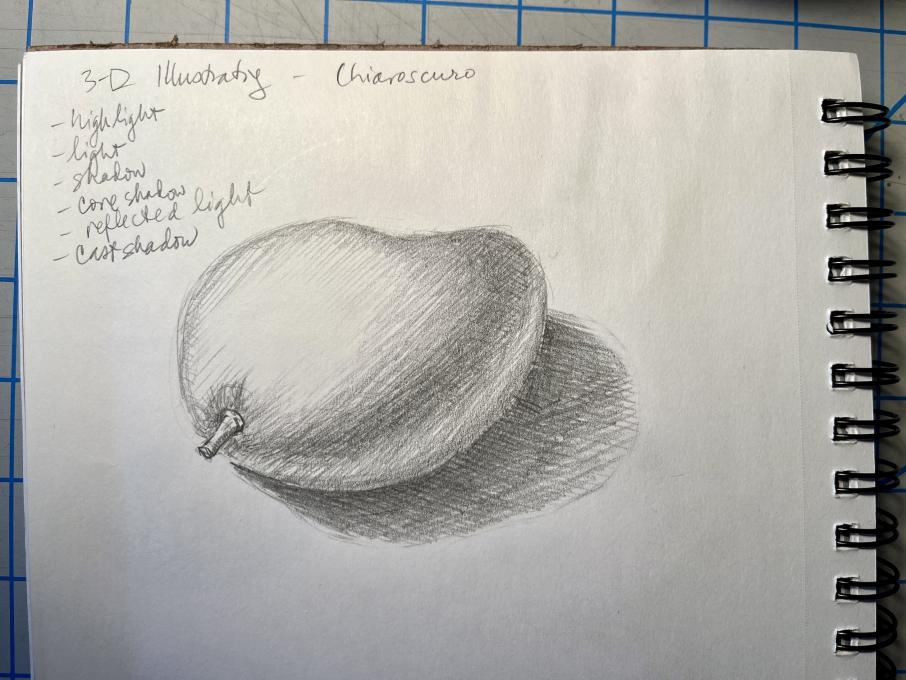 Was fun looking for the various parts of the chiaroscuro. I was curious that my mango had another band of shadow below the reflected light - I think it might have been reflected off the darkest cast shadow? I was glad for the freedom to experiment with the different types of marks - sometimes the hatching was enough, but I found myself cross-hatching and scribbling too. I appreciate others' comments on the difficulty of finding the chiaroscuro in a highly textured object!
Was fun looking for the various parts of the chiaroscuro. I was curious that my mango had another band of shadow below the reflected light - I think it might have been reflected off the darkest cast shadow? I was glad for the freedom to experiment with the different types of marks - sometimes the hatching was enough, but I found myself cross-hatching and scribbling too. I appreciate others' comments on the difficulty of finding the chiaroscuro in a highly textured object! 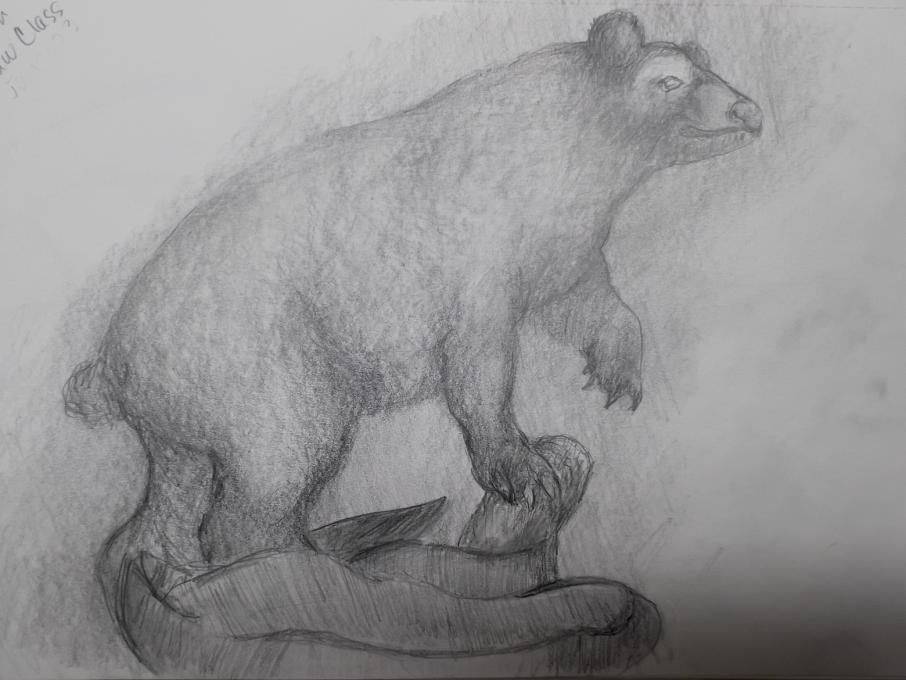 I did not care for my former attempts at creating three d. I am blaming it on the 10.5 inches of snow. I went to the Audubon center that is near and sketched the bear. Hope this is better.
I did not care for my former attempts at creating three d. I am blaming it on the 10.5 inches of snow. I went to the Audubon center that is near and sketched the bear. Hope this is better. 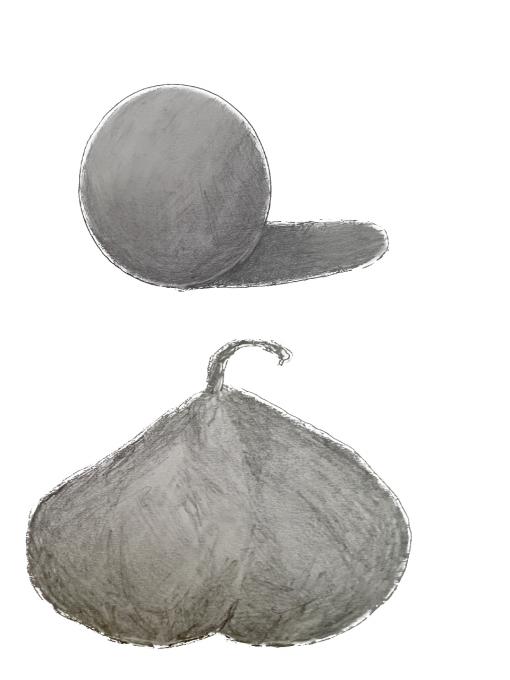
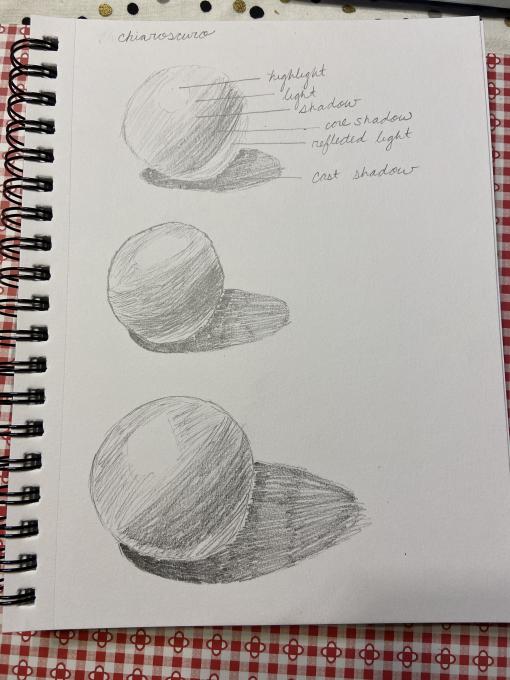 I remember this being hard in my high school art classes, and it certainly hasn't gotten any easier. I feel like it got a little easier with each attempt, although I certainly have a long way to go! I also want to work on my light, sketchy marks -- my tendency is to go too heavy and dark right away.
I remember this being hard in my high school art classes, and it certainly hasn't gotten any easier. I feel like it got a little easier with each attempt, although I certainly have a long way to go! I also want to work on my light, sketchy marks -- my tendency is to go too heavy and dark right away. 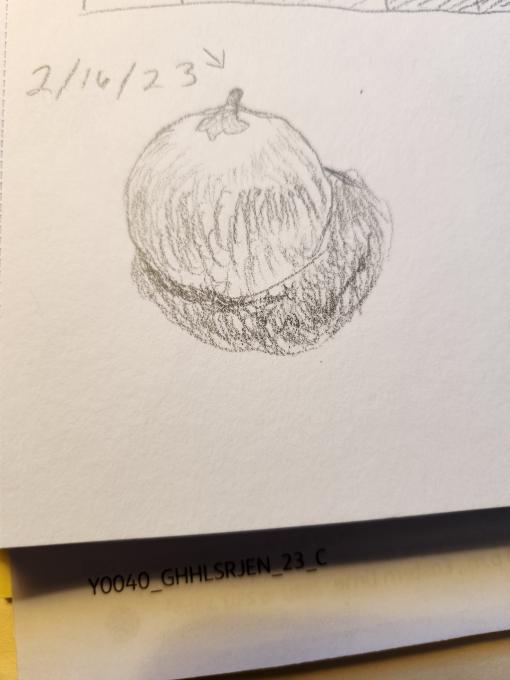
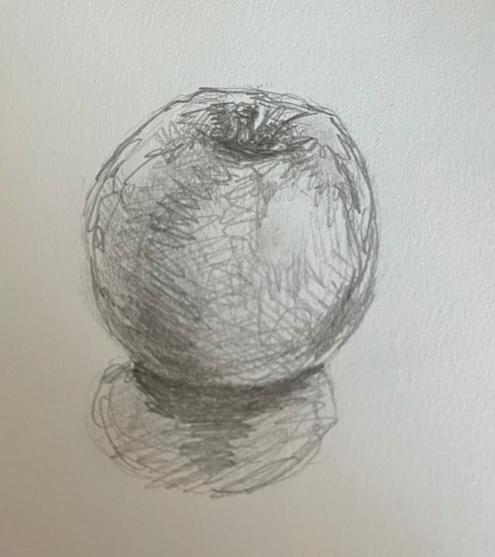
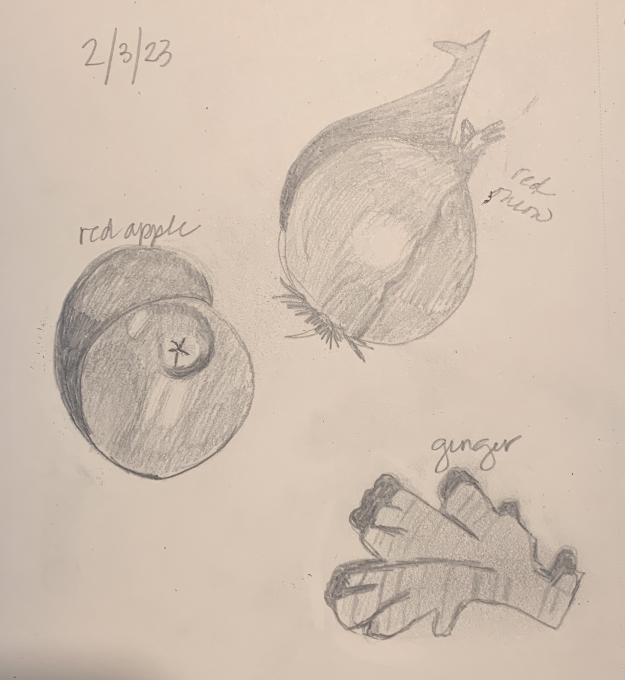 Very fun...but not very realistic...not a chicken! it is an onion!! ha...I loved learning about Chiaroscuro. I love that kind of information because it helps me to better understand what I'm seeing.
Very fun...but not very realistic...not a chicken! it is an onion!! ha...I loved learning about Chiaroscuro. I love that kind of information because it helps me to better understand what I'm seeing. 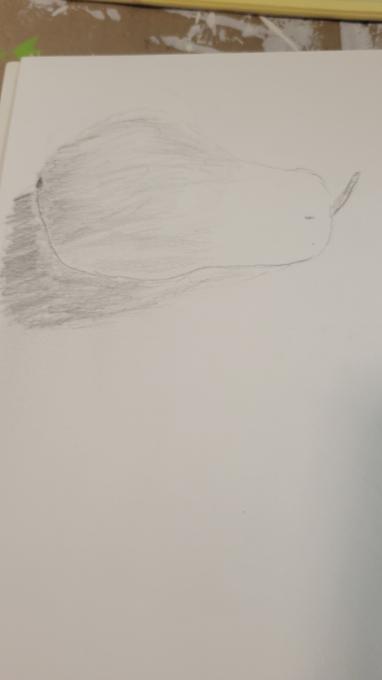 For me this is a whole new way of looking at things. I can see how the different shading and blending techniques really make a difference in your drawings. Lighting makes a difference too. Today was very cloudy and the lights in my office were casting weird shadows which made it difficult for me to see some of the highlights and shadows.
For me this is a whole new way of looking at things. I can see how the different shading and blending techniques really make a difference in your drawings. Lighting makes a difference too. Today was very cloudy and the lights in my office were casting weird shadows which made it difficult for me to see some of the highlights and shadows.
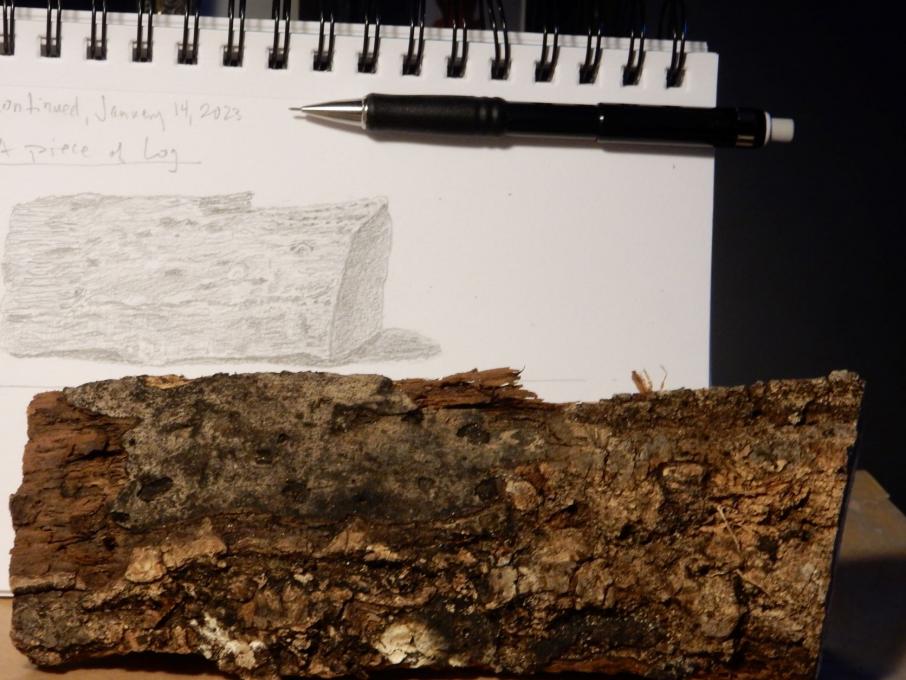
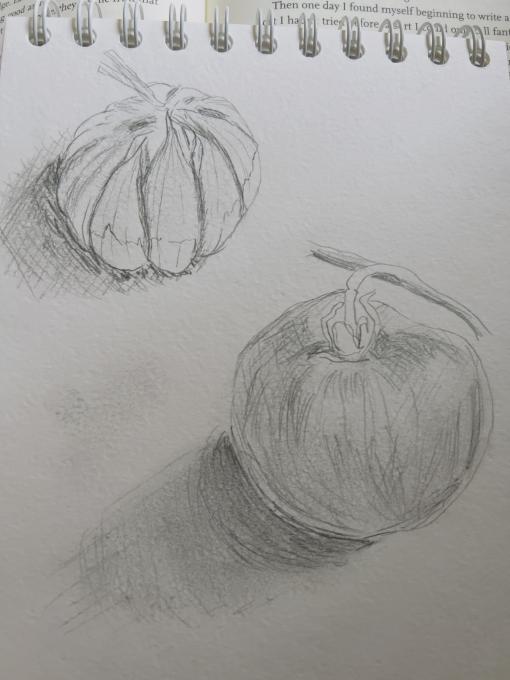
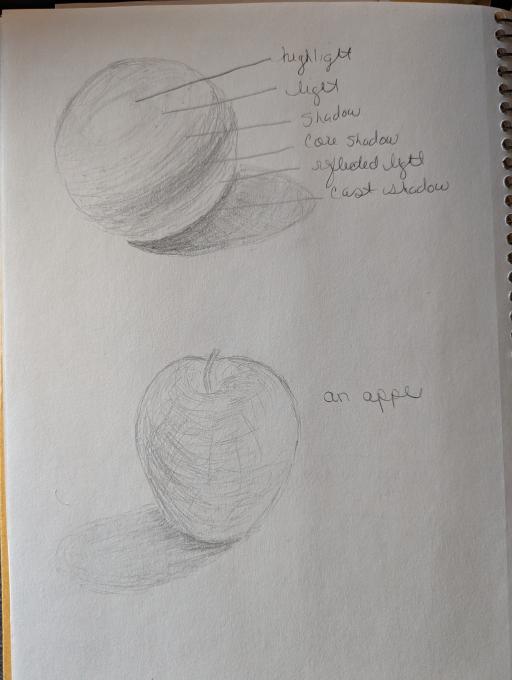
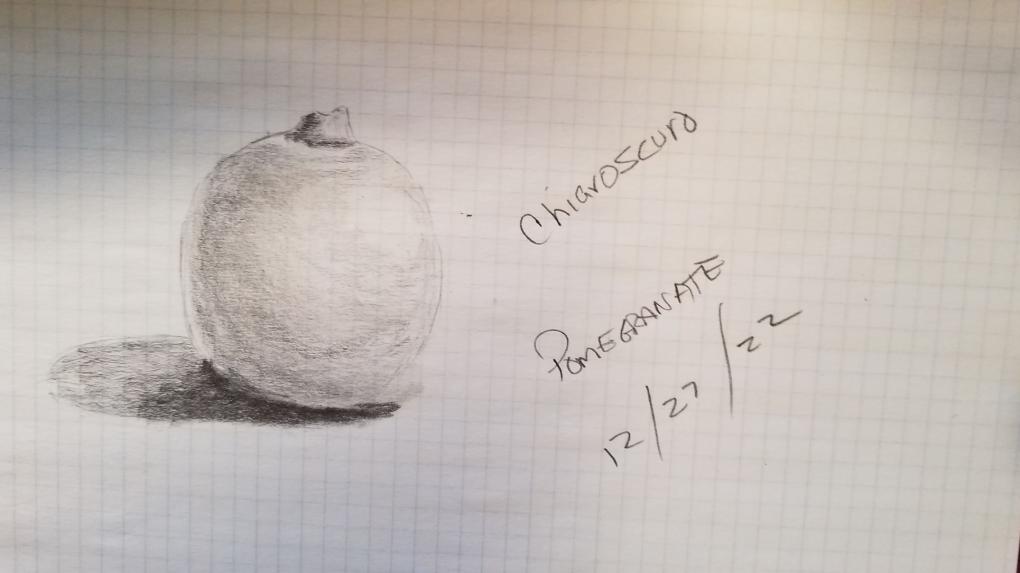
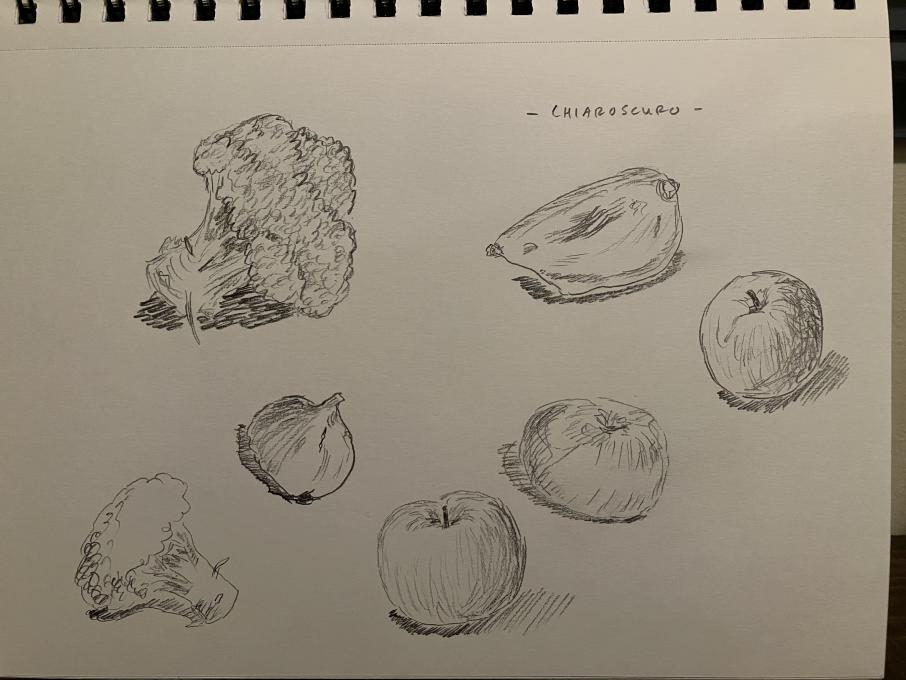
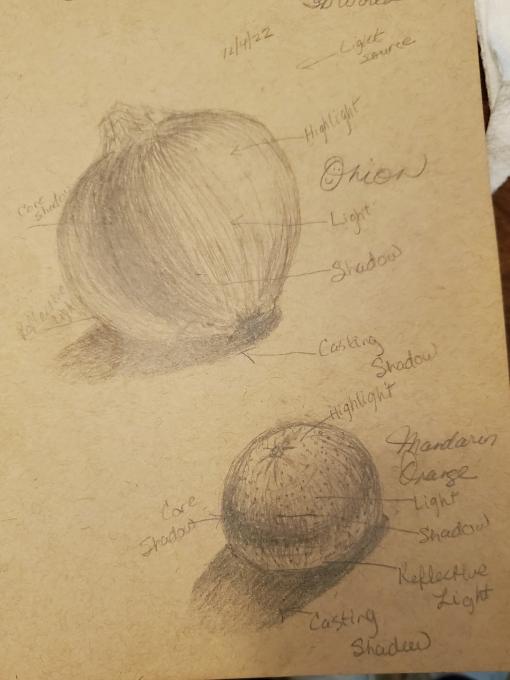
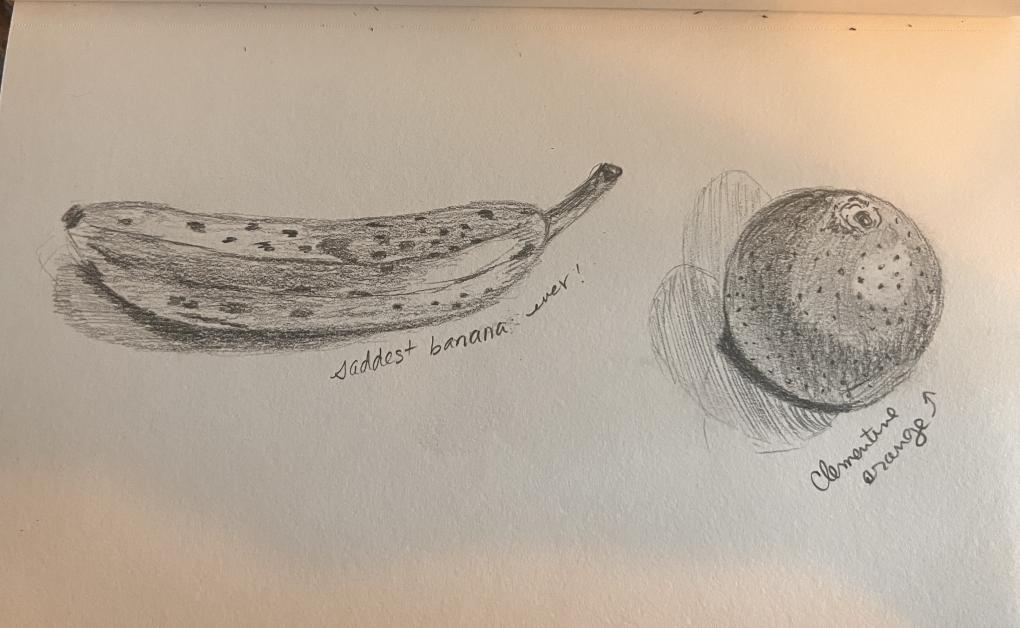
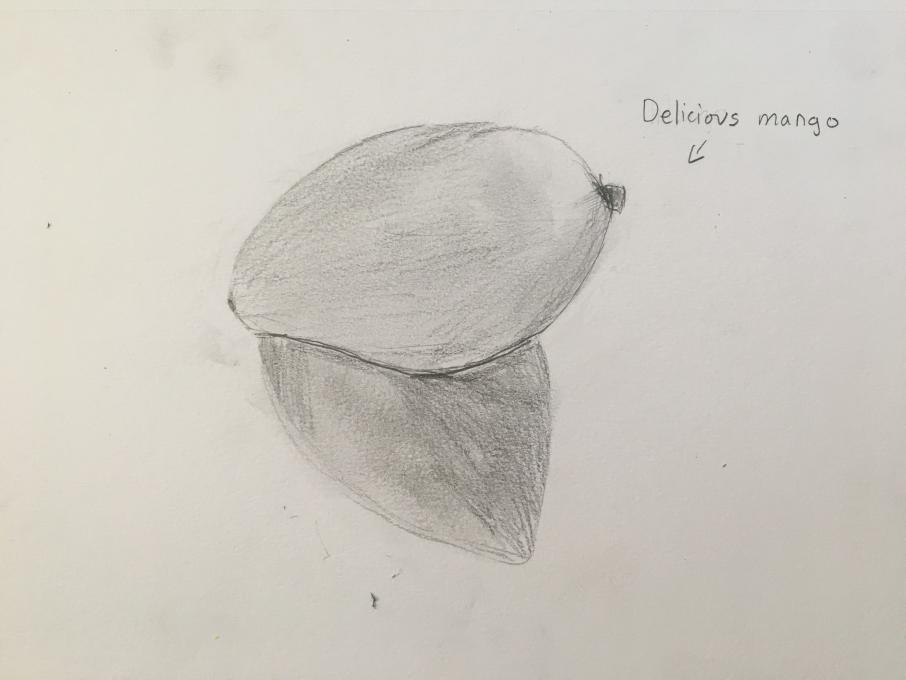
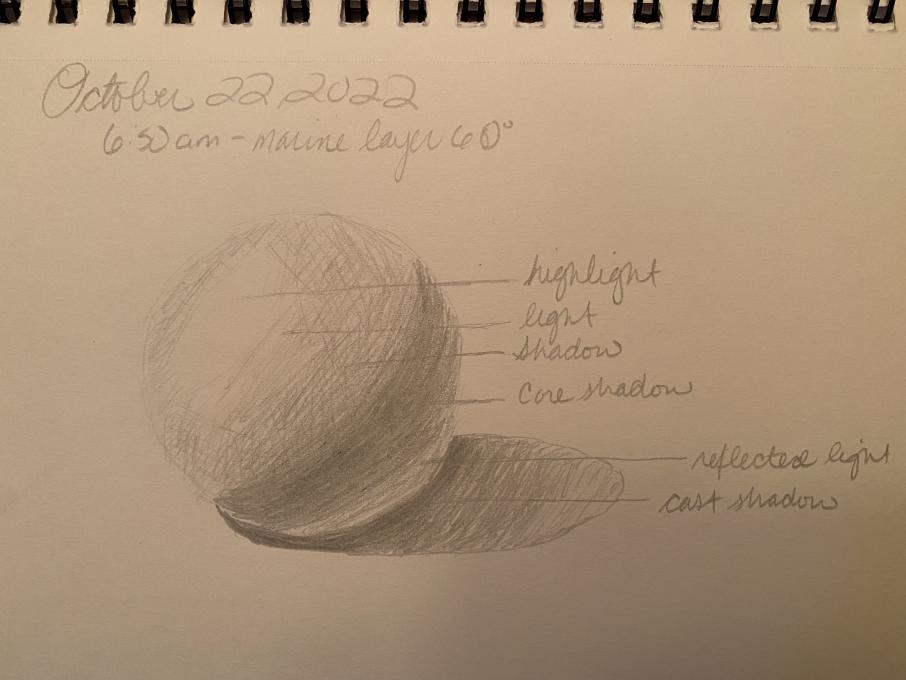 This is a challenging exercise, especially when applied to objects other than a shiny sphere. The squint test is incredibly helpful. It has been so interesting to look at the world as variation between light and shadow.
This is a challenging exercise, especially when applied to objects other than a shiny sphere. The squint test is incredibly helpful. It has been so interesting to look at the world as variation between light and shadow. 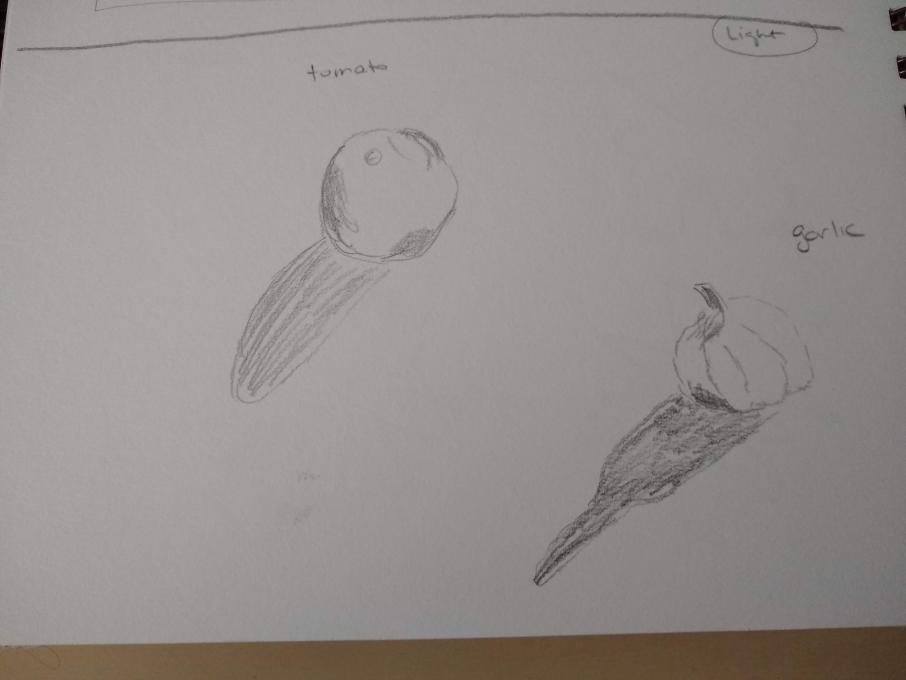
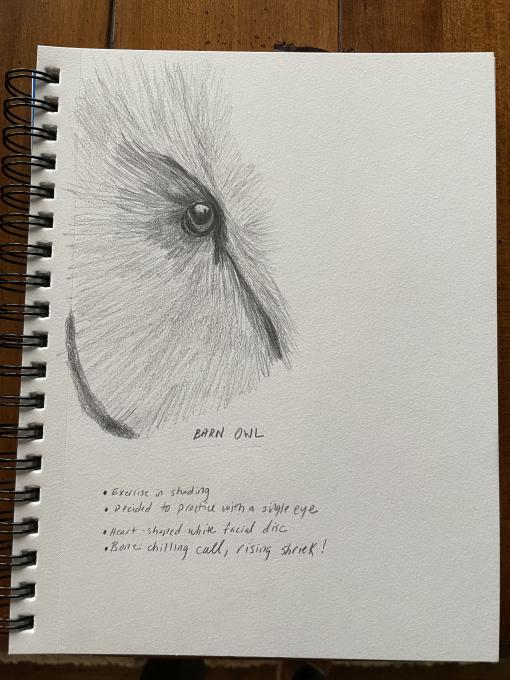 This was a great exercise! I have never sketched in my life. I love nature, gardening to attract pollinators, nature photography and bird watching. I saw this course and thought I would try it to relieve stress and I loved the idea of journaling and sketching. So I decided to draw a single eye from a barn owl. It was fun and learning about depth of field is exciting. Thank you Liz for this course.
This was a great exercise! I have never sketched in my life. I love nature, gardening to attract pollinators, nature photography and bird watching. I saw this course and thought I would try it to relieve stress and I loved the idea of journaling and sketching. So I decided to draw a single eye from a barn owl. It was fun and learning about depth of field is exciting. Thank you Liz for this course. 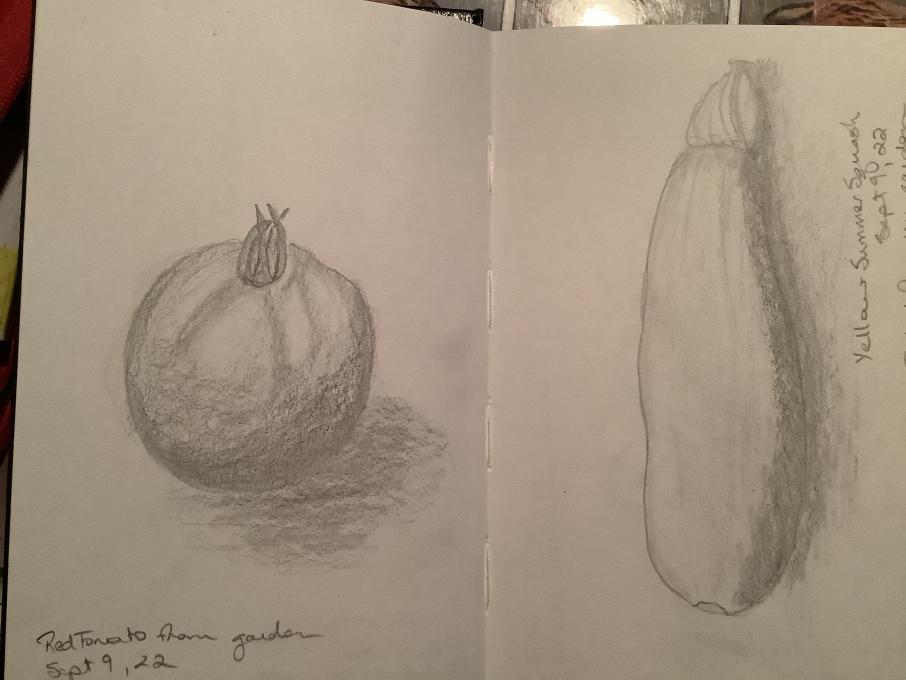
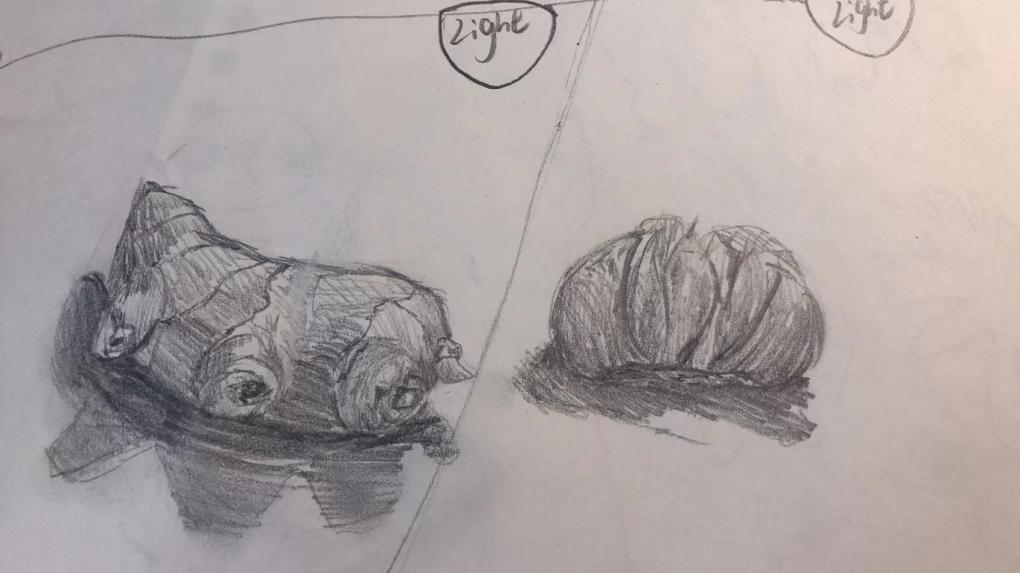 This is the ginger and garlic I drew. The light source is in the upper right corner. Through comparison, I found that due to the different textures of the objects, sometimes it is possible to distinguish light and dark quickly, but sometimes it is not possible. For example, ginger and garlic, the surface of garlic is smooth, so it is easier to distinguish the highlights and shadows on the bright surface; while the surface of ginger is rough, so the highlights are not particularly obvious, and it is also a little difficult to divide the layers in the bright surface. In addition, I also found that by adjusting the curvature and strength of the strokes, the objects can be better represented, but I am not proficient in this area. By the way, where do you start drawing first when you are drawing and what is the order of drawing? I sometimes don't know where to start.
Practice makes perfect!Come on!
This is the ginger and garlic I drew. The light source is in the upper right corner. Through comparison, I found that due to the different textures of the objects, sometimes it is possible to distinguish light and dark quickly, but sometimes it is not possible. For example, ginger and garlic, the surface of garlic is smooth, so it is easier to distinguish the highlights and shadows on the bright surface; while the surface of ginger is rough, so the highlights are not particularly obvious, and it is also a little difficult to divide the layers in the bright surface. In addition, I also found that by adjusting the curvature and strength of the strokes, the objects can be better represented, but I am not proficient in this area. By the way, where do you start drawing first when you are drawing and what is the order of drawing? I sometimes don't know where to start.
Practice makes perfect!Come on! 